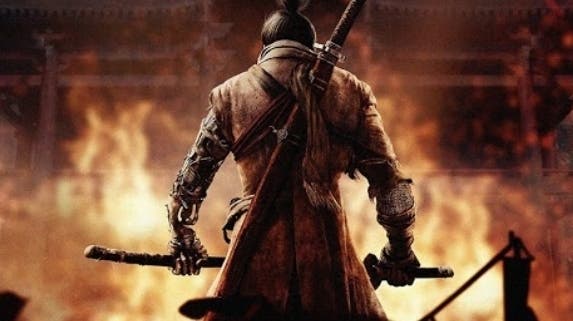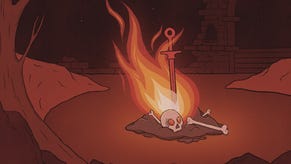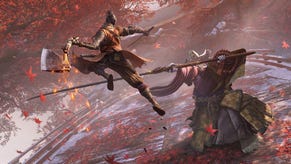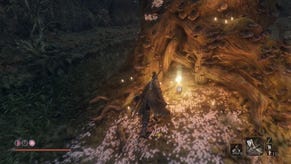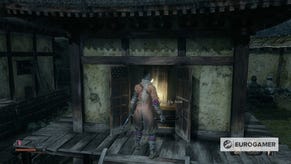Sekiro is a faster, slimmer Souls game that channels the spirit of Tenchu
Thoughts from a few hours with a review build.
Tell me, fellow kids: have any of you ever practised kinhin walking meditation? There are probably more poetic breakdowns but basically, it's about moving very slowly, half-step to half-step, in time with your breath, while trying not to fall over. It's a pleasant way to clear your head after, oh, I don't know, a couple of hours spent banging out some hasty pre-review impressions of a forthcoming video game. And at the risk of causing your eyes to roll permanently backward into your skull, it reminds me strongly of Dark Souls.
Kinhin magnifies your sense of space, you see, turning rooms into valleys, tables into distant plateaus, and that's a Dark Souls mood to the marrow. You don't hurry through the game, not unless you've played it so often that avoiding, say a bridge-length deluge of fire is a question of muscle memory. Rather, you inch boldly forth, shield held before you like a crucifix, shoulders clenched, bladder squeaking. You are a lone pawn on the chessboard, facing an endless quantity of queens, rooks and bishops. It's a recipe for caution, to put it mildly, and one consequence is that the world of Dark Souls, an in-itself massive environment, feels absolutely ginormous. Six feet in Lordran are worth six hundred in any other game, simply by virtue of the concentration you're asked to apply to every, potentially fatal centimetre.

Among the many surprises of Sekiro: Shadows Die Twice is that you don't have to linger quite as much on every footfall. Yes, the game's desolate Sengoku-era Japan is absolutely jumping with dreadful people and creatures, many of them lurking in blindspots, and many of them endowed with abilities (e.g. horribly drawn-out back-break attacks) that will slay you instantly. But you are much better able to get around them, or rather over them, thanks to protagonist Sekiro's upgradeable prosthetic arm. Among its basic functions is a grappling hook, which yanks you towards pre-specified points like a shabby, grimdark Spider-Man. Tap it again mid-air and you can latch onto another point without touching down - chaining your leaps into a swooping, aerial tour of some beautiful terracotta rooftops and bamboo-furnished cliffs, leaving unpleasant entities like ogres to choke on the dust from your coat-tails.
It transforms how you think about the Dark Souls DNA that snakes through Sekiro's notionally historical setting. Yes, there are still campfire-type things - Sculptor's Idols - that serve as fast travel points, but you might actually do without them, because it's such uncomplicated fun to flip and zip across the landscape. Yes, there are bosses, and sometimes you'll need to defeat them to unseal a misty portal to the next area, but a lot of the time, I've been able to slip quietly past, saving the encounter for another day. You are no longer a pawn on the chessboard. You're a knight, leaping over other pieces, sizing up gaps in the line. True, it makes the world of Sekiro feel a bit less imposing than Lordran, but the sheer delight of the grapple in motion - the twisting of Sekiro's torso as he throws out another line, the billow of dislodged snow when you land on a branch - is ample compensation.
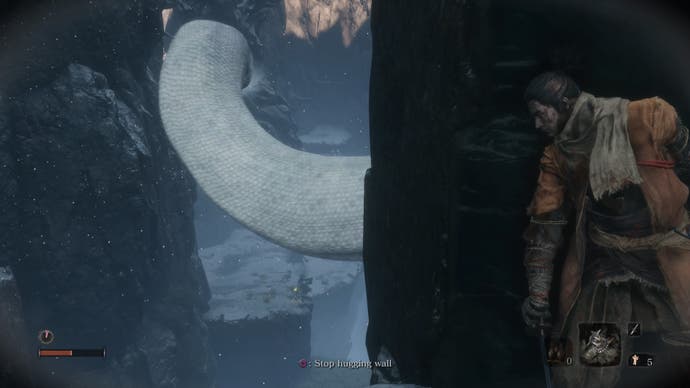
The critical background here is that Sekiro is as much a spiritual successor to Tenchu, From's once-proud ninja series, as it is a continuation of the Soulsborne format. You see that most obviously in the emphasis on stealth and assassinations, with Sekiro able to press himself against walls to lower his profile, and one-hit basic foes by catching them from behind or above. Enemies have awareness indicators, and the opening areas brim with neck-high vegetation and crawlspaces that render you all but undetectable. Man, to have been able to lurk in the shrubbery during my initial run against Ornstein and Smough!
This is far from a pure assassination game, though - firstly, because certain aspects of the stealth feel half-hearted, with distraction items that never seem to work for me, but mainly because stealth attacks do not always kill outright. Larger samurai and monsters take several "deathblows" to defeat, as indicated by the dots alongside their health bar, and to perform these, you'll need to master the game's exacting Posture system. Landing blows slowly fills up a bar that, once full, staggers the target and allows you to perform a meaty finisher.

Sometimes, just hammering the attack button is enough, but cannier opponents will punish you for doing this, and in any case, parrying an incoming strike fills up the bar a lot faster. It's an intriguing evolution of stamina from Souls and Bloodborne, and while you can dodge and counter like any good Chosen Undead, it pushes the emphasis toward rapid exchanges - attack, block, attack, attack, parry, deathblow. Or as the case often is with me, attack, attack, get parried, take a katana to the kidney, flee to a gable's end to douse myself in healing oils. Should your swordsmanship be less than scientific, a devious resurrection system allows you to return from death after your foe has turned away. There are narrative consequences for dying excessively I won't spoil, but it makes an agreeable cushion for the combat's predictably steep learning curve.
There are, so far, no primary weapons besides Sekiro's trusty katana, but upgrades to your ninja prosthetic together with unlockable special moves allow for more creative strategies and no shortage of flair. At the time of writing I can switch between a shuriken launcher, a short-ranged flame cannon (as useful for paralysing larger opponents with terror as searing their flesh) and a pop-out axe that can be used to shatter shields. I can also deflect arrows in mid-air and pinion opponents with my grapple - satisfying indeed, when a boss hurls you across a courtyard and you lasso his head and reel yourself back into the fight.
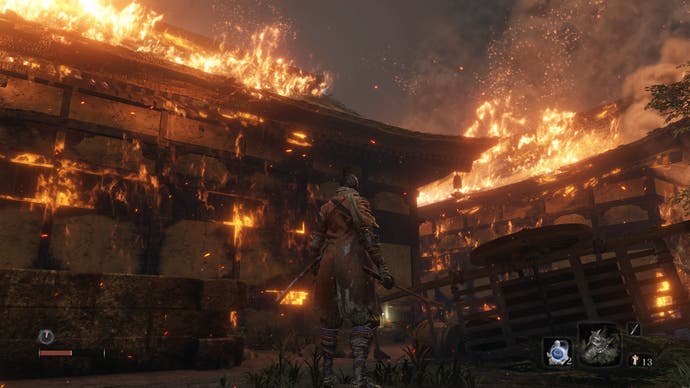
There's clearly some breadth to all the kidney-stabbing, a sentiment that also applies to the game's deceptively linear-looking environments, though Sekiro is much less dense with variables than the Souls series. There's little stat customisation here save for basic health and attack power upgrades, which will disappoint min-maxers, but I don't feel like the game is any less engrossing for it. And besides, after four From games' worth of hoarding embers and overclocking greatswords, it's nice to have a change of air. On the strength of a few hours spent backflipping across its skyline, Sekiro is a blast, and I'm looking forward to bringing you a full verdict next week.
